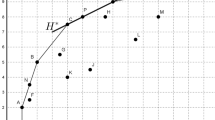Abstract
Sensitivity and robustness of efficiency classifications for the additive model and its geometric equivalents in Data Envelopment Analysis (DEA) are addressed. The minimum distance (measured by a Tchebycheff norm) separating an organization from reclassification is computed via linear programming formulations and shown to constitute a generalized ‘residual’ for each organization. Without this sensitivity information, findings can be distorted when marginally efficient or inefficient units are distinguished solely on the basis of their classification. Analysis of these residuals from an earlier (inconclusive) DEA study further reveals how substantive differences in a sample's underlying groups can be detected. Properties of group efficiency and group proximity to the efficient frontier are investigated using these new indicators.
Similar content being viewed by others
Author information
Authors and Affiliations
Rights and permissions
About this article
Cite this article
Rousseau, J., Semple, J. Radii of Classification Preservation in Data Envelopment Analysis: a Case Study of ‘Program Follow-Through’. J Oper Res Soc 46, 943–957 (1995). https://doi.org/10.1057/jors.1995.133
Received:
Accepted:
Published:
Issue Date:
DOI: https://doi.org/10.1057/jors.1995.133




